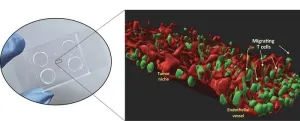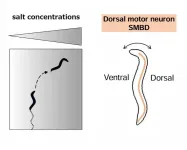(Press-News.org) The exponential demand for high computing power is far exceeding the capabilities of current electronic systems; however, engineers at the University of Pittsburgh are shining a light on new solutions.
Nathan Youngblood, principal investigator and assistant professor of electrical and computer engineering at Pitt’s Swanson School of Engineering, received a $552,166 Faculty Early Career Development Award from the National Science Foundation (NSF) and a $449,240 award from the Air Force Office of Scientific Research (AFOSR) through its Young Investigator Program (YIP) to continue his pioneering work in phase-change materials and optical computing.
“Dr. Youngblood is a rising star and one of the finest young researchers, scholars, and educators at Pitt Engineering,” said Alan George, Department Chair, R&H Mickle Endowed Chair, and Professor of Electrical and Computer Engineering and SHREC founder. “His two latest achievements – the CAREER Award and the AFOSR Young Investigator Award – are truly exceptional and we are so proud of him and excited about his growing research program and group of students.”
Optical computing, also called photonic computing, has shown promise over conventional hardware by using light waves produced by lasers or other sources for data storage, data processing, or data communication for computing. However, current technology limits its practicality.
With these awards, Youngblood will be investigating two different approaches to improve the speed, reliability and efficiency of optical computing. The first approach focuses on using the wave-like nature of light to increase the efficiency of optical computing while the second focuses on improving optical memories to increase computational throughput.
Computing in the World of AI
For his CAREER Award, Youngblood’s will focus on developing high efficiency optical computing hardware to address crucial challenges of artificial intelligence (AI).
“As AI applications services continue to become more prominent, we need the computing power to be able to support them,” Youngblood said. “There have been notable advancements in modern computers, but gains in traditional hardware efficiency are unable to keep pace with these data-hungry systems. Optical computing makes it possible.”
When current computing methods try to meet the demands of AI, unwanted heat is created because of the vast amounts of data moving at high speeds through the metal wires of the processor.
“Photons don’t have this heating issue, so you can process data much faster using light,” Youngblood explained. “Right now, however, optical processors aren't powerful enough, accurate enough, or efficient enough to be truly useful for AI.”
Thanks to funding through Pitt’s Momentum Funds, Youngblood was able to secure an initial seeding grant and preliminary data for his CAREER Award.
“I’m incredibly thankful for Pitt’s help in jumpstarting this research,” Youngblood said.
An Upgrade in Modern Computing
It’s pretty clear modern computing systems have hit their limit.
Existing computer hardware is hindered by the movement of data between memory and processing cores, reducing computing speeds and creating unwanted heat in the machine.
Through the Young Investigator Program, Youngblood will create photonic hardware which enables computation to occur in the optical memory array itself, drastically reducing the movement of data. His lab will conduct research in three main thrusts: improving the efficiency, reliability, and repeatability of electrically programmable phase-change photonic memory; designing fully analog multilayer photonic networks for fast and efficient computing; and demonstrating a multi-layer, fully analog photonic in-memory accelerator on chip.
The outcomes of this work will advance the development of novel materials for reconfigurable photonic devices and integrate these components into optoelectronic computational systems.
“The resulting platform is expected to have significant impact for Air and Space Force applications requiring ultra-low latency computation, target discrimination, and autonomous navigation where there is an immediate need for extremely high speed information processing,” Youngblood said.
The project, “Photonic in-memory accelerators for low-latency and efficient computing,” is part of the $21.5 million given to YIP recipients who receive three-year grants of up to $450,000. Individuals selected must show exceptional ability and promise for conducting basic research of the Department of the Air Force relevance.
In addition to the scientific contributions to the next step in optical and modern computing, Youngblood’s CAREER award will also help him cultivate a diverse high-tech workforce in the greater Pittsburgh area. Initiatives include creating affordable educational tools exposing students to nanotechnology applications in AI, conducting STEM workshops in collaboration with Pitt’s outreach program (LEAD), and mentoring undergraduate researchers through Pitt’s EXCEL summer research program. Voluntary assessments will measure educational outcomes, providing quantifiable metrics for the project’s broader impact on workforce diversity and innovation in AI.
END
Computing with the power of light
2024-01-22
ELSE PRESS RELEASES FROM THIS DATE:
Cholangiocarcinoma: New organ-on-chip aims at accelerating research and personalized medicine
2024-01-22
Milano, January 22nd 2024 – It is only a few centimeters in size and can be held between two fingers, but in the micro-channels carved inside it, it’s hidden a three-dimensional and highly faithful model of a biliary tract cancer called cholangiocarcinoma, complete with its tumor microenvironment. This 3D model is built starting from a sample of patient’s cancer cells and thus it represents a patient-specific "organ-on-chip": a technology made possible only through a multidisciplinary approach that merges biomedicine, physics and engineering.
The innovative prototype is the result ...
Bioengineered material developed to rapidly stop bleeding in patients on blood thinners
2024-01-22
More than 11 million people in the United States take anticoagulation or antiplatelet medications, such as heparin or aspirin, to treat serious conditions like heart attack and stroke. However, these medications also put patients at risk of life-threatening bleeding in the case of injury or during surgery. To improve strategies for reducing blood loss, a team led by investigators from Brigham and Women’s Hospital, a founding member of the Mass General Brigham healthcare system, developed a porous material that maximizes blood absorption and effectively activates clotting mechanisms, even in patients on anticoagulation or ...
New biomarkers for active lupus nephritis discovered
2024-01-22
New biomarkers with improved diagnostic performance for early detection of lupus nephritis have been discovered in the University of Houston lab of Chandra Mohan, a pioneer in lupus research. Early identification of renal involvement in lupus and prompt treatment are essential in reducing the pain, suffering and eventual mortality it causes.
Systemic Lupus Erythematosus (SLE), commonly called lupus, is an autoimmune disease that occurs when the body attacks its own tissues and organs. Inflammation from the disease can impact many different parts of the body including joints, skin, kidneys, blood cells, brain and heart. Lupus nephritis is one ...
New research examines how assumptions affect motion capture technology
2024-01-22
Motion capture technology has applications in a wide range of fields, including entertainment, medicine, and sports, to name a few. But what if the measurements these systems were based on were rooted in social practices and biased assumptions, leading to errors that become ingrained over time?
This question is at the heart of new research co-authored by Mona Sloane, an assistant professor of data science and media studies at the University of Virginia.
Sloane and her co-authors — Abigal Jacobs, an assistant ...
Scientists identify mutations that cause inherited kidney disease
2024-01-22
Genetic changes or mutations can cause hereditary kidney disease, which can eventually lead to dialysis or the need for kidney transplantation. Identifying the cause of inherited kidney disease is the first step in identifying a treatment.
With that goal in mind, researchers at Wake Forest University School of Medicine and the First Faculty of Medicine of Charles University in Prague, Czech Republic, have discovered a new genetic cause of inherited kidney disease.
The findings were recently published in Kidney International.
According to Anthony J. Bleyer, M.D., ...
How the brain responds to reward is linked to socioeconomic background
2024-01-22
MIT neuroscientists have found that the brain’s sensitivity to rewarding experiences — a critical factor in motivation and attention — can be shaped by socioeconomic conditions.
In a study of 12 to 14-year-olds whose socioeconomic status (SES) varied widely, the researchers found that children from lower SES backgrounds showed less sensitivity to reward than those from more affluent backgrounds.
Using functional magnetic resonance imaging (fMRI), the research team measured brain activity as the children played a guessing game in which they earned extra money for each correct ...
New reagent improves the process of making sulfur-containing compounds that may be used in medicines
2024-01-22
During the past decade, there has been significant development of new sulfur containing compounds that are used in various industries, including pharmaceuticals and agricultural products. Sulfoximines, sulfonimidoyl fluorides and sulfonimidamides are types of sulfur-containing chemical compounds that have wide-ranging potential as therapeutic drugs. However, the synthesis process for these compounds is complex and has several limitations. In a new article published in Nature Chemistry, Moffitt Cancer Center researchers describe their ...
New candidate for universal memory is fast, low-power, stable and long-lasting
2024-01-22
We are tasking our computers with processing ever-increasing amounts of data to speed up drug discovery, improve weather and climate predictions, train artificial intelligence, and much more. To keep up with this demand, we need faster, more energy-efficient computer memory than ever before.
Researchers at Stanford have demonstrated that a new material may make phase-change memory—which relies on switching between high and low resistance states to create the ones and zeroes of computer data—an improved option for future AI and data-centric systems. ...
Follow the salt: connecting salt concentrations and motion in roundworms
2024-01-22
Joint research led by Ayaka Matsumoto and Yuichi Iino of the University of Tokyo demonstrated that temporal decrease in salt concentration leads to the activation of the neck motor neuron of roundworms only in a specific phase of its activity. The activation adjusts the roundworm's trajectory toward higher salt concentrations. The finding pinpoints the neural mechanism by which roundworms integrate sensory and motor information, a first step toward understanding the neural mechanisms of navigation in more complex animals. The findings were published in the journal Proceedings ...
Planetary Commons: Fostering global cooperation to safeguard critical Earth system functions
2024-01-22
“Stability and wealth of nations and our civilisation depends on the stability of critical Earth system functions that operate beyond national borders. At the same time, human activities push harder and harder on the planetary boundaries of these pivotal systems. From the Amazon rainforest to the Greenland ice masses, there are rising risks of triggering irreversible and unmanageable shifts in Earth system functioning. As these shifts affect people across the globe, we argue that tipping elements should be ...


